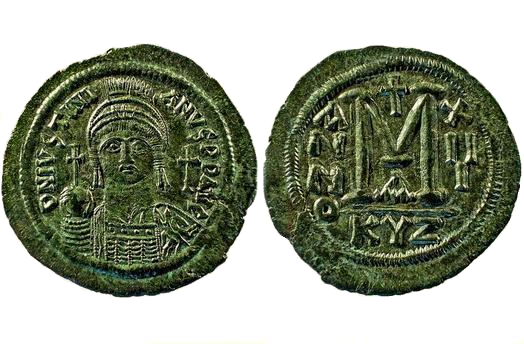
about ancient nomos
Ancient Nomos Art is a museum of galleries exhibiting ancient coins and ancient mint maps. The coin gallery displays the diverse art and history of hand-crafted ancient Greek, Roman, Byzantine, Persian and Medieval coinage. The ancient mints mapping gallery features Greek, Roman, Byzantine, Asia Minor and Medieval mint city regions and territories. Visitor's are welcome to explore, study and enjoy Ancient Nomos Art.

Byzantine, Roman – 539 AD
Justinian I
From Ancient Galleries

Obverse: Emperor Justinian facing, wearing cuirass and helmeted, holding globus cruciger in right hand, shield emblazoned with horseman in left, cross above.
Reverse: Large M centered; cross above, ANNO to the left, KYZ mint mark below.
LEGEND
Obv: D N IVSTINI-ANVS PP AVG, Facing bust of Emperor Justinian I wearing cuirass and helmet, holding globus cruciger and military shield emblazoned with galloping horseman. Rev. Large M in center; with cross above, ANNO to the left, X/III to the right; KYZ mint mark, officina A above.
Historians continue to argue that the Roman transformation from Byzantine to Medieval might have been altogether different had it not been for Justinian’s reign. His edicts and assaults as the leader of the Western Empire provided the cause and desire to begin a split between the Roman Eastern Empire and the Western Empire. Justinian’s deep desire for change also included the Roman monetary system. His was the second great Byzantine reform of coinage after that of Anastasius. This bold new Roman follis was increased in size to be as large as a medallion. The total weight of this coin is over twenty two grams, with a diameter averaging +/- 45 millimeters, creating one of the broadest bronze coins ever minted. The obverse art portraiture of the follis was changed in 538 AD from profile portrait to a full facing imperial bust. This piece depicts Justinian facing forward and wearing his cuirass breastplate and military helmet, while holding a globus cruciger and shield emblazoned with a galloping horseman. The reverse features a large Greek letter M in the center. This is the coins denomination mark indicating a value of 40 nummi per follis. In 537 AD, the Count of the Sacred Largess, Peter Barsymas, extended Roman provisions of law requiring all government documents to be dated, including coinage. The legend ANNO for “year” in Latin appears to the left of the M, with a dated year 13, or 539 AD of Justinian’s reign, appearing as the Roman numerals XIII to the right of the M. Above the M is a Christian cross. Below the M are the mintmarks: KYZ for the city of Cyzicus and a small A shape directly beneath the M is the Greek numeral “1” for the first mint-office within the city. This magnificent coin was very impressive, but impractical and consequently reduced in size by the regnal year fourteen, and disappearing completely by regnal year sixteen.
DOCUMENTATION
Value: Follis. Metal: Æ Bronze. Weight: 22.01 grams. Mint: Cyzicus. Date: Regnal Year 13, 539 AD.
Attribution: Dumbarton Oaks Collection, I 165b; Hahn, Moneta Imperii Byzantini I 120a; Sear, Byzantine Coins and their Values, 207.
Legend, Documentation and Attribution
